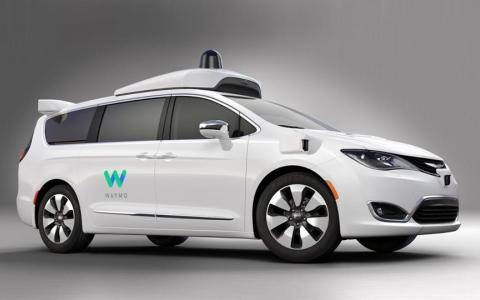
There are a lot of puzzle pieces that have to come together in order for automated driving to become safe, reliable and ubiquitous.
Sophisticated sensors and wireless communications can provide the raw data about what is around each vehicle. But that’s all a jumble of meaningless bits unless the system can parse through it and make sense of the environment the vehicle has to move through.
That’s the job of the software and the compute platform and Intel today announced that it is collaborating with Waymo to power its automated driving system.
In today’s automated driving space, Intel and Nvidia are widely seen as the two leading providers of the compute platforms needed to crunch through the 4 TB of data that these vehicles are capable of generating every hour. Nvidia is harnessing the massively parallel processing capability of its leading edge graphics processors to fuse the information from radar, cameras and lidar sensors to understand what is moving, where it’s going and how fast.
Intel on the other hand has been the world’s largest silicon chip maker for decades and its processors have long dominated the market for personal computers. However, in recent years, Intel has struggled as the demand for traditional computers has declined in favor of mobile devices like smartphones and tablets. Intel tried and failed to crack the mobile market which is dominated by more energy efficient chips based on the ARM architecture.
Automated driving and the internet of things (IoT) presents a growing market that Intel hopes to grab a significant slice of. Along with its silicon manufacturing expertise, Intel’s strength has long been in general purpose computing. In an automated driving stack, there are two basic types of computing tasks.
There are the highly parallel operations required for the artificial intelligence and machine learning done in the so-called perception system.
Those jobs run great on graphics chips like those from Nvidia as well as specialized processors like field programmable gate arrays (FPGAs) and those from Mobileye.
The time critical operations to actually manage the actuators that make a vehicle go, stop and turn run very well on the types of processors that Intel has specialized in. Thus over the past two years, Intel has augmented its product portfolio with the acquisitions of FPGA maker Altera and machine vision experts Mobileye.
In mid-2016, BMW announced that it would partner with Mobileye and Intel for the development of its automated driving platform. Automotive supplier Delphi also chose Intel and Mobileye to power its own driving stack.
In August of this year, BMW, Intel and Mobileye announced that they would be opening up their partnership to additional companies with Fiat Chrysler Automobiles (FCA) being the first to join.
Waymo has been collaborating with Intel since the development program launched back in 2009.
Waymo spokesman Johnny Luu explained that the team "wanted a partner that they could grow with, that had the capacity to supply a lot of high-performance computing capability."
In addition to general computing capabilities for processing sensor data and controlling the system, Intel is also providing connectivity capability within the vehicle network. Waymo hasn't revealed specifications of its in-house developed sensors but commercially available lidar from companies such as Velodyne can generate 300,000 points per second. Current production vehicle networks cannot handle anywhere near that much data.
The announcement that Intel is powering Waymo’s fleet of automated Chrysler Pacifica hybrids actually comes as a bit of a surprise. It has been speculated that along with designing its own sensor hardware, Waymo may use its own custom designed chips based on the Tensor processing units (TPU) announced at its developer conference earlier this year.
The TPU is highly optimized for machine learning applications and running Google's TensorFlow artificial intelligence software. At some point, Waymo may indeed follow that path, but for now at least, it will stick with Intel's most advanced CPUs and FPGAs.
At least for the first generation or two of automated vehicles, it’s unlikely that there will be one clear winner on the computing front. Volvo, Toyota, Tesla and suppliers Bosch and ZF are all using Nvidia-designed hardware. Waymo, BMW and Delphi are going Intel. However, there are still plenty of undeclared players and many of them are likely to follow a similar path to Audi.
The zFAS control unit that powers the semi-automated Traffic Jam Pilot in the new A8 utilizes a combination of Nvidia system on a chip, Mobileye vision processor and Intel-Altera FPGAs and at least one other automaker has indicated on background that they plan to combine Nvidia GPUs with Intel CPUs for its platform.
The other players
While Intel and Nvidia get all the attention, there are also a number of other chip providers with history in supplying the automotive industry including Renesas, NXP and Qualcomm.
Qualcomm is actually in the process of acquiring NXP to further expand its automotive footprint and offer more integrated solutions. Samsung is another potential player, especially with its recent acquisition of Harman, which already supplies communications and infotainment systems to many of the world’s automakers.
While these companies may not have the high-end processors needed to be the primary compute platform for highly automated vehicles, they still have a part to play.
Level 4 and 5 automated vehicles that are capable of operating without humans aboard will require an increased level of redundancy than has traditionally been used in the auto industry. Since there may be no human to act as the backup controller, extra computers will be needed to safely manage these vehicles.
Navigant Research's Automated Driving Technologies report projects that as many 9 million highly automated vehicles will need redundant compute platforms by 2026 lower powered systems from Renesas, NXP and others could fill that niche. As vehicles get more advanced, the demand for capable yet power efficient microprocessors will continue to grow.



